Europe 2000
I didn't take many pictures this trip.
Taking really good pictures takes time, mostly to get the light right.
Most good pictures are taken during what photographers refer to as the
"magic hour", the hour around sunset and the hour around sunrise when colors
are saturated.
So, this page is mostly text. You can actually
read it, or just look at the pictures, which will be loading while you
read this. All the pictures are full-sized, intended for a screen of at
least 800 by 600 pixels.
Saturday, May 27. In the belly
of the beast.
Some people think international travel
is glamorous. People with experience at it tend to think differently,
at least those of us not fortunate enough to be willing to spend the money
to travel first-class in the Concord.
Lisa and I refer to international travel
as being "in the belly of the beast". It's like being swallowed by
a large animal, which ingests you on the day of departure. You spend
an unpredictable amount of time in the innards of the beast, getting progressively
more tired and more dirty. Eventually, the beast poops you out at
a place that may or not be where you wanted to go.
Our flight out of Intercontinental to London
Gatwick was two hours late taking off. That meant that we would miss
our connection to Paris, so instead of getting onto a Paris-bound flight
at 9 o'clock on Sunday morning, we were rescheduled onto the first flight
leaving after that, which was at 4 o'clock in the afternoon.
Except the aircraft, aided by unusually
strong winds in the jetstream, made up the deficit, and we landed approximately
on time. But since our bags had been tagged for the 4 P.M. flight,
which there was no way to change, we spent the day in Gatwick airport,
rather than spending the day in the Paris airport waiting for our bags.
Ah, the glamour of international travel!
Actually, it wasn't that bad. If
you read my narrative of our last European trip,
you'll recall that I got to Paris too tired to figure out the gearshift
on the rented car. This time, I got an hour or two of sleep in the
Gatwick airport, and arrived in Paris feeling much better. We had to spend
about an hour waiting for our rental car, and we got to have a spirited
discussion with the rental-car clerk, who was eager to sell me a lot of
insurance on the car we didn't need, about which a note. If you are
relying on your credit card company to supply insurance on a rented car,
which many like my American Express Card do, be sure you read the fine
print from the credit card company. For example, Amex's policy is
invalid on cars rented in Ireland, Italy, Australia, and New Zealand, among
other places. Also note where the rented car may be driven to - the
one we rented could not be driven into former Communist-block countries
like Czechoslovakia.
We spent the night in Paris at a hotel
close to the airport, since we didn't feel like finding a campsite around
Paris. Next time, we'll go to the lovely campground near the town
of Maison Lafitte.
Monday, May 29th.
We were still jet-lagged, though, which
led to a poor decision. We wanted to head toward Avignon, in the
south of France, so we started off in that direction, stopping in an Auchan
to stock up on food and other goodies we needed, like fuel for our camping
stove, which one cannot carry onto an airplane. The poor decision was to
drive too far, arriving at our intended destination, the municipal campground
in Clermont-Ferrand, 20 minutes after the campground office closed.
We got to spring for another night in a hotel, which would be the last
on this trip until our last night in Paris. (Since we had to be at the
airport at 5:00 A.M. on the day of departure, camping was not an option.)
It was a nice drive, though, though the
mountains of central France. We stopped a couple of times to look
at some ruins, and most of the day was spent on RN roads, the "Routes National"
which were the main French highways before the construction of the highspeed
divided highways referred to as Autoroutes, the equivalent of U.S. Interstate
highways.
We resolved thereafter to stop driving
by 5:00 P.M. to find a camp site, as we had passed several nice-looking
ones.
Tuesday, May 30
A mercifully short drive to Avignon. We
got in around 2:00 P.M., and set up camp in the lovely campground on an
island in the river, a 15 minute walk across the bridge to town.
Allow me to remind you that unlike American
campgrounds, where the assumption is that most campers arrive in large
motorhomes, European campgrounds assume that most people are camping in
tents or very small trailers. Virtually all have nice facilities
for washing dishes and doing laundry by hand. Many have stores selling
food, wine, and other essentials, and most are in towns or within a comfortable
walk to them. France, the size of Texas, has 10,000 campgrounds,
most of which are run by the small towns in which they are located.
And they're not expensive. We spent the equivalent of $15 to $20
per night to camp with four people in two tents. If you've priced European
hotels lately, you may have some appreciation for what a bargain that is.
And the campgrounds are easy to find in
most cases. Drive into the center of town, and look for signs bearing
the international symbol for a campground, which is a tent.
Wednesday, May 31
We spent the day exploring Avignon, afoot.
The Palais du Papes, the Palace of the Popes, is architecturally impressive
for a structure built during the 12th century. I was not aware until
reading its history that the Popes of the Catholic Church ever resided
anywhere other than in Rome, but they did, and Avignon was one of the places.
The girls got to do some shopping on their own in town, while Lisa and
I walked back to camp in the late afternoon.
Thursday, June 1, Avignon to Nice,
France
We spent part of the day driving down to
Nice, the last part of which we drove on the coast road through Cannes,
which was very busy. We got surprised by the fact that it was a public
holiday, Ascension Day, and the stores were closed.
Europeans, especially the French, observe
a lot of holidays which Americans don't, and we've learned to keep some
"iron rations" in the car, in case we get surprised by unanticipated store
closings and can't buy food. Also, European grocery stores are often completely
closed on Sundays, with some being opened on Sunday mornings. Planning
for surprises is important.
A good backup if you get caught unprepared
is to get on an Autoroute. The Autoroutes have rest stops, called
"Aire" in France, and the bigger ones have stores similar to convenience
stores in the U.S. where one can find essential supplies.
In Nice, we set up at Parc des Maurettes,
where we stayed on our previous trip. It's within walking distance
of the beach and a big Intermarche grocery store. Grocery prices
in Europe are comparable to U.S. prices for the most part. French
stores have table wine which is cheaper than Coca-Cola, and, of course,
baguettes, the bread which is the staple of French life. We really
miss those baguettes, which the equivalent of cannot be found in the U.S.
We started out most mornings with baguettes, eaten either with cheese or
butter and jam, and coffee.
Nice has the nicest beaches we found in
Europe. They're made of nicely rounded pebbles and rocks, rather
than sand, which means your suit doesn't get filled with sand, and have
showers spaced every hundred meters or so for washing off the salt.
I could spend a long time sitting on those beaches looked at the lovely,
cool, Med, and I intend to in the near future.
Friday, June 2
Went for a run in the morning, and to the
beach in the afternoon. Life is tough.
Saturday, June 3. Nice to Pavia,
Italy.
We drove a lovely mountain road up toward
Pavia, in the central part of Italy, avoiding the autoroutes. Nice
drive. We followed the campground signs to a nice grassy, shaded campground.
It was quite warm away from the cooling influence of the Med, and there
were a few mosquitos in the grass around dusk.
Sunday, June 4. Pavia to Venice.
We drove to Venice, actually to a campground
on a peninsula a short ferry ride from Venice. The camp was quite nice,
with excellent facilities. Since it was Sunday, we got caught for about
an hour in the traffic going to the beach from Venice. That was kind
of frustrating, because a primary reason for going out to that peninsula
was to avoid big crowds of people. That tactic is probably successful,
except on Sundays.
Monday, June 5. Touring Venice.
For about $30, we bought a family ticket
which paid for our ferry ride to town, plus any public boat transportation
in Venice, for a 24-hour period. It was quite a bargain, and we used it
to ride all around Venice on the public boats, which are used by the locals
like land buses to get from one part of town to another. During one of
those rides, we saw a wonderful juxtaposition of the ancient and the modern,
a gondoleer paddling his boat with one hand while talking on a cellular
phone with the other.
The ruler of Venice in the middle ages
was called the Doge, and we touring the Doge's Palace. It was very
impressive, and had lots of art which featured many views of the city during
that period. We also walked across "The Bridge of Sighs" to the prison.
The bridge is called that because that was the sound made by the prisoners
as they entered the prison, perfectly understandable after a tour of the
prison.
Tuesday, June 6. Touring Venice.
We messed about in camp in the morning,
and in the afternoon dressed up for dinner and went to town. We toured
the Academia Art Museum before having dinner late. Dinner for four
in a nice restaurant was 172,000 Lira, about $85.00. It's easy to
be a millionaire in Lira. There were lots of tourists after dark in St.
Mark's Square, where we had some ice cream, which is reasonably priced
in Italy and very good. Venice is wonderful after dark.
On the walk back to camp from the ferry,
we stopped to watch a wonderful fireworks display over the city, the reason
for which we had no idea.
Italy was hot. We had intended to
go from Venice to Florence and then to Rome. We decided instead to
go to Austria.
Wednesday, June 7. Venice to Vienna.
We packed up, and drove over the mountains,
having to stop at the border, exchange currency, and get a stamp which
allows passage on the Austrian Autoroutes, which unlike many French Autoroutes,
are not toll roads. The stamp wasn't very expensive. The Austrian
Shilling was about the inverse of the Franc to the dollar. The Franc
was about 7 to the dollar, and the Shilling 14. It was kind of confusing,
and it will be nice when they get currency for the Euro into circulation.
European currencies were about 20 percent cheaper with respect to the dollar
than on our previous trip, which was nice. Forget traveler's checks
- ATM machines are everywhere, including many larger grocery stores. You
may have to look for them, though, as they're not called ATM machines.
In France, the most common term was "Distributeur de billets", which means
Ticket Distributer. Beats me.
We camped at Kloster-Neuberg, a short drive
from Vienna. Driving in European cities is a hassle, with parking scarce
and expensive and street widths often designed for oxcarts. It's
rarely necessary, as public transportation is cheap and mostly easy to
figure out.
The campground was great, with grassy sites.
I rigged our 10-foot by 12-foot tarp for the first time on this trip, because
we got an afternoon shower. We took a three-person tent for Lisa and me,
a two-person tent for the girls, and the tarp for shade and rain protection
while cooking and lounging.
Thursday, June 8. Vienna.
We toured the Schonbron, a little 1441-room
"hunting lodge" used by Austrian emperors, which was built on what were
then the outskirts of the city. It was wonderfully preserved and
furnished, including bedrooms and office furniture used by Franz Joseph,
an interesting character and confirmed workaholic, who had trouble with
his wife Elizabeth because of the strictures of living in the royal family
as well as his work ethic.
An interesting bus pulled into camp.
It was rigged as a mobile hotel for bicyclists, which it was following
about. It had 21 tiny sleeping cubicles rigged crossways in the back,
accessible by a canvas-covered platform which lowered from the side of
the bus in its road configuration. A canvas-covered kitchen folded out
from the sides. The bus was manned by the cook and a driver, and
pulled a trailer for carrying the bicycles when the riders were traveling
by bus rather than on their bikes. It was very well thought-out.
The riders traveled mostly on their bicycles, and caught up with the bus
at night in a campground. There are a lot of great roads for bicycling
in Europe, and not having to carry camping gear on the bikes makes for
a wonderful way to travel, though I'm sure it's not inexpensive.
Friday, June 9. Vienna.
We caught the train into town - the round-trip
fare was about $5.60 per person on a daily basis - and toured the Imperial
Apartments, which were less impressive than they might have been had we
not seen the Schonbrun. Vienna has great churches, including Saint Stevens,
which was damaged heavily in WWII. The smaller Academia church, though,
was more ornately decorated.
Vienna to me just seemed like another big
city. I enjoyed seeing it, but I've no personal interest in going
back, unlike many of the places we visited.
Saturday, June 10. Vienna to Hallstatt,
Austria.
Hallstatt is a little town of 1400 people
beside a lake a couple of hours drive from Vienna, closer, actually, to
Salzburg, in a mountainous region known as the Salzkammergut popular with
vacationers. The town is very quiet when the tour buses leave in
the late afternoon.
 This
is Lisa and the girls, with Hallstatt in the background. The town is lovely.
As many places in the European mountains, the houses are sturdily built
to take snow loads and the people seem to really love flowers - many if
not most of the houses have flower boxes in the windows and lovely gardens.
Roses seem to be popular and love the cool mountain temperatures. This
is Lisa and the girls, with Hallstatt in the background. The town is lovely.
As many places in the European mountains, the houses are sturdily built
to take snow loads and the people seem to really love flowers - many if
not most of the houses have flower boxes in the windows and lovely gardens.
Roses seem to be popular and love the cool mountain temperatures. |
 This
is the view from the other side of Hallstatt. There is a salt mine
at Hallstatt. This area was populated from pre-Roman days because
of the salt deposits from which Salzburg derives its name. There is a cable
car which goes several hundred feet up the mountain behind town to the
salt mine. We were kind of touristed-out when we got there, and just
spent a couple of days in town resting. The town is small and secure
enough for Sarah and Emily to explore without much supervision, and Lisa
spent some time one morning making pencil sketches in the town. It
was nice to rest. This
is the view from the other side of Hallstatt. There is a salt mine
at Hallstatt. This area was populated from pre-Roman days because
of the salt deposits from which Salzburg derives its name. There is a cable
car which goes several hundred feet up the mountain behind town to the
salt mine. We were kind of touristed-out when we got there, and just
spent a couple of days in town resting. The town is small and secure
enough for Sarah and Emily to explore without much supervision, and Lisa
spent some time one morning making pencil sketches in the town. It
was nice to rest.
We got into town too late on Saturday to
get to the market, which closed at noon. It was closed on Sunday
as a matter of routine. We expected to buy food on Monday morning
on the way out of town toward Salzburg, only to find that Monday was another
one of those unexpected holidays and the stores were closed. This time,
though, we had most of what we needed, and stopped in a Shell station's
convenience store for bread and breakfast food on the way. |
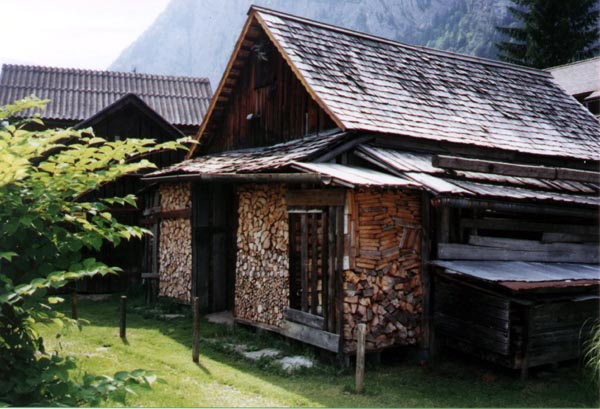 In
the mountains, much heating is still done using wood stoves. The
"storage walls" seen on this shed was a common pattern. In
the mountains, much heating is still done using wood stoves. The
"storage walls" seen on this shed was a common pattern. |
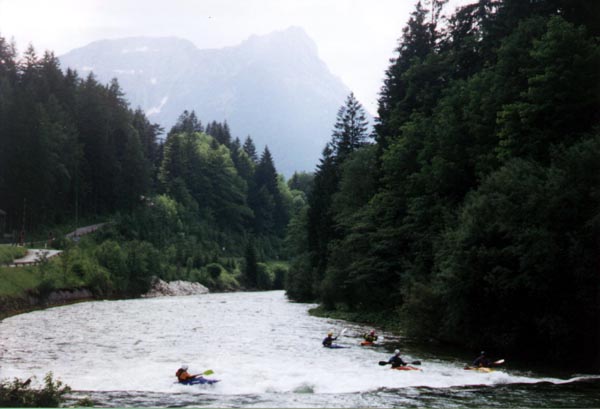 On
Sunday, Lisa and I drove east and south from Hallstatt, around the Hallstattsee,
and up the east side of the lake on a lovely mountain road. We found
these kayakers playing just below a dam on the Traun river near Bad Aussee.
They were doing rolls and endos and other maneuvers I don't know the correct
names for. On
Sunday, Lisa and I drove east and south from Hallstatt, around the Hallstattsee,
and up the east side of the lake on a lovely mountain road. We found
these kayakers playing just below a dam on the Traun river near Bad Aussee.
They were doing rolls and endos and other maneuvers I don't know the correct
names for. |
Monday, June 12. Hallstatt to Salzburg,
Austria.
Salzburg is the town in and near which
the movie The Sound of Music was filmed, but we didn't hold that
against the town, and in fact it was our favorite bigger town from this
trip, aside from Paris. To encourage the tourists, they sell a "Salzburg
Card" with a microchip on it, which allows the holder to see almost all
of the common tourist spots in town without additional charge as well as
riding the public buses. It's a bargain. We saw a lot of things
in 48 hours, including the State Apartments, the church and the church
museum, which has a gilded cross in it dating from 700 A.D., Mozart's birthplace
as well as a later residence of his. We toured the Hohensalzburg Fortress,
which rises above the city, and is sufficiently formidable never to have
been taken by battle or seige. Standing on its ramparts, one can see why.
It also has a nice army museum, with good displays of historic and modern
weapons.
The town is very friendly to tourists,
with lots of shopping, sidewalk cafes and restaurants, and, most important,
conveniently placed public restrooms. Our campground, to the north, had
a wonderful view of the town, and one evening we enjoyed a lovely fireworks
display looking back toward town. I chatted at length with an Australian
couple who had taken a year off to go touring, and who had come north like
us to escape the heat, but from Greece, which was even hotter than Italy.
Wednesday, June 14. Salzburg to Brunnen,
Germany.
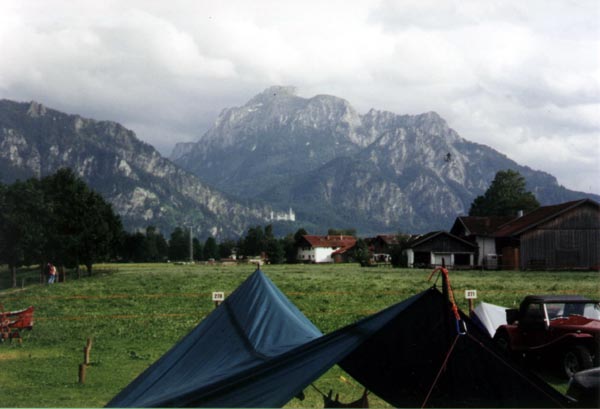 What,
you might ask, is at Brunnen, Germany? In the picture you will find the
tarp we rigged for sun and rain protection while camping. Just over the
rear pole holding up the tarp you can just barely see in the distance Mad
King Ludwig's castle of Neuchwanstein, which is the castle Walt Disney
used for a pattern in creating the Disney "Magic Castle". Not visible is
another of the mad king's castles, at Hohenswangau. The two, a short
walk apart, are an enormous tourist attraction. If you're going to
visit them, the best advice is to go early or late, but not in the middle
of the day when the lines are long and the parking scarce. What,
you might ask, is at Brunnen, Germany? In the picture you will find the
tarp we rigged for sun and rain protection while camping. Just over the
rear pole holding up the tarp you can just barely see in the distance Mad
King Ludwig's castle of Neuchwanstein, which is the castle Walt Disney
used for a pattern in creating the Disney "Magic Castle". Not visible is
another of the mad king's castles, at Hohenswangau. The two, a short
walk apart, are an enormous tourist attraction. If you're going to
visit them, the best advice is to go early or late, but not in the middle
of the day when the lines are long and the parking scarce.
And, aside from driving by to recon the
parking lot, we didn't go in them. We intended to, but things happen...
The day we drove in, there was a furious
thunderstorm around 6:00 P.M. which lasted until 01:10 the next morning
- I know the rain stopped exactly then because the absence of it woke me
up to look at my watch. The next day, we decided to take a break from touring.
The girls wanted to ride bikes, and rentals were available at reasonable
prices, so we let them do that while Lisa and I took a long walk into Schwangau
around the lake. Our intention was to tour the castles the next day, and
leave the following day.
When we woke up on Thursday, we found the
weather had deteriorated - it was about 50 degrees and drizzling, with
no sign of a change. We packed up the tents wet, and blew off the
castles, headed toward France which we figured would be dry since it was
on the other side of the mountains. Next time the castles, maybe. |
Friday, June 16. Brunnen, Germany
to Challon en Champagne, France.
We were right - it wasn't raining in France.
We found the municipal campground by the usual method of following the
signs from downtown, and the campground was lovely, with huge grass sites
and immaculate bathrooms. We got all the wet gear dried out, and
had a lovely dinner.
Saturday, June 17. Challon to Saumur,
France.
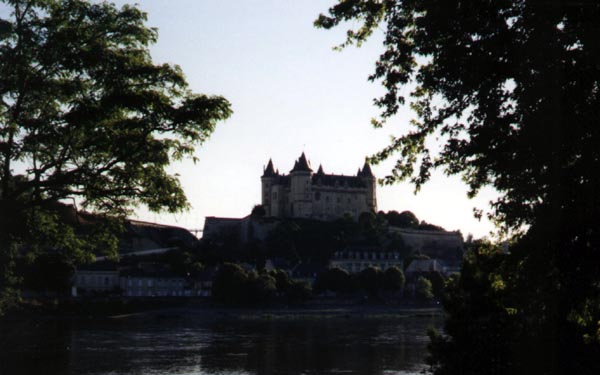 Saumur,
on the left bank of the Loire about halfway between Angers and Tours, is
the home of the French Cavalry School as well as the national School of
Equitation. There are also caves there used as wine cellars and for growing
mushrooms - three-quarters of all of the mushrooms of France are raised
in the caves, some of which are available for touring. Saumur,
on the left bank of the Loire about halfway between Angers and Tours, is
the home of the French Cavalry School as well as the national School of
Equitation. There are also caves there used as wine cellars and for growing
mushrooms - three-quarters of all of the mushrooms of France are raised
in the caves, some of which are available for touring.
This is the chateau, as viewed from our
camp. Very imposing, it was never captured. It's a great place
to tour - beside the structure itself, it has a horse-oriented museum,
including tack and outfits from cavalry units worldwide. They even
have some from Texas "cow-boys", as the label had it. |
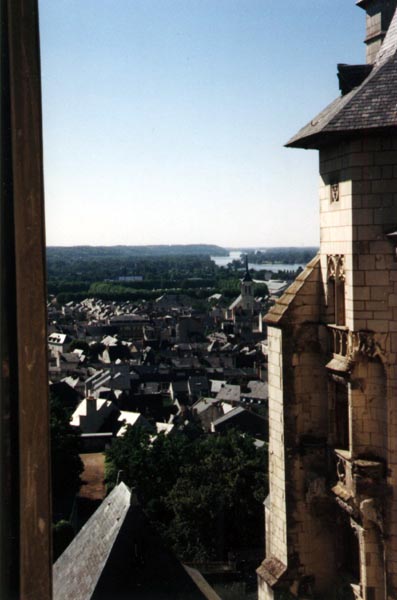 This
is the view of town from one of the windows of the chateau. It's a great
walking town, with big pedestrian-only areas of shops and restaurants,
and within easy walking distance of the campground which is actually on
an island a short walk away. This
is the view of town from one of the windows of the chateau. It's a great
walking town, with big pedestrian-only areas of shops and restaurants,
and within easy walking distance of the campground which is actually on
an island a short walk away. |
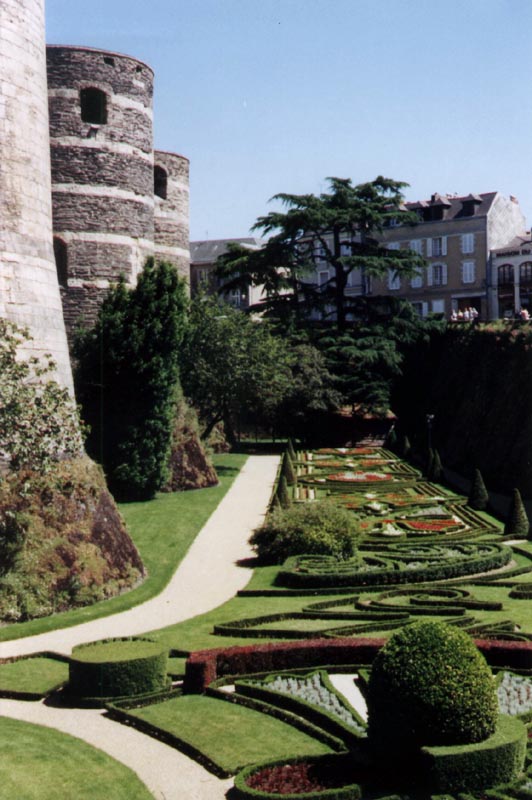 On
Sunday, June 18, we drove over to Angers. We intended to go see the
one of the caves containing mushrooms, but the road down the riverbank
was closed because of a gathering of 30,000 bicyclists. That's a
lot of bicyclists in one place. On
Sunday, June 18, we drove over to Angers. We intended to go see the
one of the caves containing mushrooms, but the road down the riverbank
was closed because of a gathering of 30,000 bicyclists. That's a
lot of bicyclists in one place.
The picture is of the gardens of the chateau
at Angers. It's a very imposing structure - the gardens shown here
are in what used to be the moat. The chateau has a nearly intact
set of ramparts one can walk around. The architecture is quite different
from other chateaus we looked at, as the walls were built using slate slabs
held together by mortar, and the roofs were also slate, which appeared
to be still in quite good condition. A note about the word "chateau".
There are two kinds of chateaus. One kind is country houses for the
nobility of France, and these were usually not fortified. But another
use of the word is applied to what are really fortifications or castles,
like the one here and the one at Saumur. The French use "chateau"
for both kinds, and so, therefore, do I, but until you see a particular
one you may not know which usage applies. This one was sufficiently formidable
that Henry III ordered the tops of the towers pulled down after a particularly
vexing campaign against the fortress during the 16th century - the tops
were originally thirty feet higher. I find European history fascinating,
and as I write this I am doing some more reading of it. The intermarriages
between the houses of nobility and all of the wars are amusing.
There is also a building on the grounds
which was specially built in modern times to house the Tapestry of the
Apocalypse, a depiction of the Biblical events which was woven in three
years starting in 1375. It's a wonderful and huge work, 550 feet
long and 16 feet wide.
On the way back from Angers, we stopped
and had lunch in a McDonalds in Saumur. It tasted great.
Then we drove over to the chateau at Chinon.
If you saw the movie The Messenger about Joan of Arc, you know that
Chinon is where Joan recognized the disguised Dauphin, and started events
which led to his coronation as king and, some think, to the modern state
of France. The events also led to her being burned at the stake,
alas. The chateau, which is not in very good condition, nevertheless is
worth the visit because it has a small but delightful museum dedicated
to Joan with some very witty audio commentary about some of the controversy
regarding whether Joan really was a messenger from God or just as nutty
as a fruitcake, and the commentary is not to be missed. |
Monday, June 19. Saumur to Mont
St. Michel, France
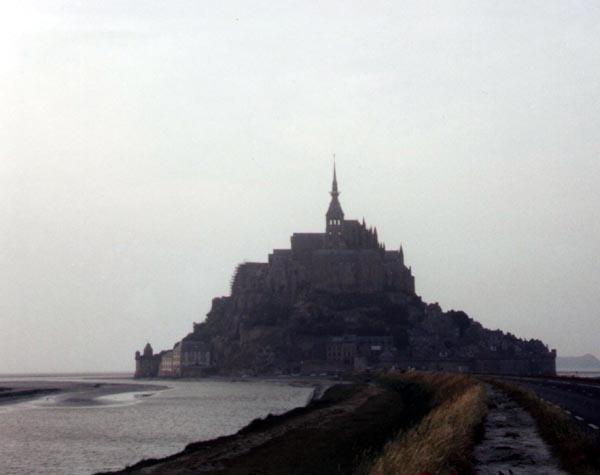 Many
people who have no idea what it is probably recognize the image of Mont
St. Michel, which was and is an abbey perched on a rock off the coast of
Brittany. It was originally only reachable during low tide, but is now
accessible most of the time via a causeway built in 1869 which is only
rarely under water. The tides in that area have a peak difference between
high and low of 45 feet or about 15 meters. Watching the tide come
in is impressive, which we did in the evening. Many
people who have no idea what it is probably recognize the image of Mont
St. Michel, which was and is an abbey perched on a rock off the coast of
Brittany. It was originally only reachable during low tide, but is now
accessible most of the time via a causeway built in 1869 which is only
rarely under water. The tides in that area have a peak difference between
high and low of 45 feet or about 15 meters. Watching the tide come
in is impressive, which we did in the evening.
There is a small town there, which is now
mostly tourist shops and restaurants. The abbey, though, is worth
a visit. It was founded in 708 A.D., though there were structures on the
rock prior to that. The abbey was built during three main periods of time,
and touring it is a wonderful glimpse into the different architectural
periods when it was built. Under the choir loft of the main church, you
can see a room with pillars 16 feet around built to support the weight
of the church. |
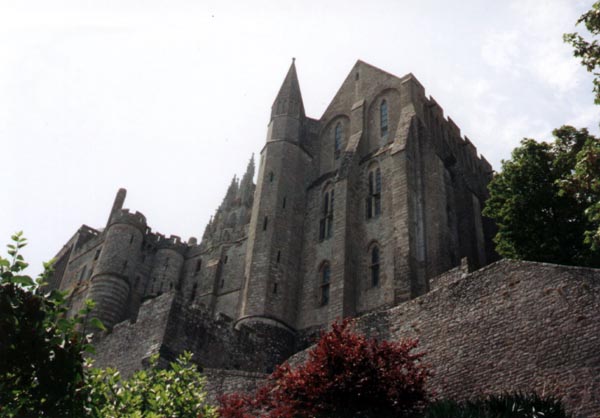 This
is the abbey. The construction of the wall in the foreground is characteristic
of the abbey as a whole. It's a wonderfully peaceful place to visit. This
is the abbey. The construction of the wall in the foreground is characteristic
of the abbey as a whole. It's a wonderfully peaceful place to visit. |
From Mont St. Michel it was back to Paris,
and to our campground at Maison Lafitte on the outskirts of Paris, on the
bank of the Seine. The town has a train station with service into Paris.
We saw the Musee d'Orsay, which is chock full of impressionist paintings.
I saw some lovely works by a couple of impressionists I was not familiar
with, Odilon Redon and Paul Signat, the latter of whom was a pointillist.
I'm trying to find a print of a painting of Signat's that I particularly
liked.
One day we split up. Lisa and the
girls went to the Museum of Fashion, and I went to Napolean's Tomb and
the French Army Museum at Les Invalides. The museum was great, with
many suits of medieval armor and lots of weapons from all of France's history.
We had a wonderful dinner one evening in town at a small restaurant with
a live jazz quartet, and arrived back around midnight satiated.
Paris is my favorite city, and France our
favorite country in Europe, though we found Austria to be a close second.
The French have, in my opinion, an undeserved
reputation for rudeness with some Americans. I have found them to
be wonderfully tolerant and helpful, though my experience may be slanted
because I took the time to learn some French before going, enough to shop
in the stores and travel around. A great way to find an English-speaking
Frenchperson is to speak to them in bad French - if you start off in English,
you may find they refuse to acknowledge having any English. I don't blame
them.
I like France, and I'm going to spend a
lot more time there in the future. Lisa concurs. We see no reason
to spend any more summers in Houston. General Phillip Sheridan, the military
of governor of Texas after the Civil War, said, "If I owned both Texas
and Hell, I would rent out Texas and live in Hell." I concur - and in France,
table wine is cheaper than Coca-Cola, not to mention that I've yet to find
an American bakery which can even come close to matching a baguette which
can be bought in any store in France.
Home
Contents copyright 2000 by Linden B. Sisk
All rights reserved.
Email:
Lindy@arcanamavens.com
 This
is Lisa and the girls, with Hallstatt in the background. The town is lovely.
As many places in the European mountains, the houses are sturdily built
to take snow loads and the people seem to really love flowers - many if
not most of the houses have flower boxes in the windows and lovely gardens.
Roses seem to be popular and love the cool mountain temperatures.
This
is Lisa and the girls, with Hallstatt in the background. The town is lovely.
As many places in the European mountains, the houses are sturdily built
to take snow loads and the people seem to really love flowers - many if
not most of the houses have flower boxes in the windows and lovely gardens.
Roses seem to be popular and love the cool mountain temperatures. This
is the view from the other side of Hallstatt. There is a salt mine
at Hallstatt. This area was populated from pre-Roman days because
of the salt deposits from which Salzburg derives its name. There is a cable
car which goes several hundred feet up the mountain behind town to the
salt mine. We were kind of touristed-out when we got there, and just
spent a couple of days in town resting. The town is small and secure
enough for Sarah and Emily to explore without much supervision, and Lisa
spent some time one morning making pencil sketches in the town. It
was nice to rest.
This
is the view from the other side of Hallstatt. There is a salt mine
at Hallstatt. This area was populated from pre-Roman days because
of the salt deposits from which Salzburg derives its name. There is a cable
car which goes several hundred feet up the mountain behind town to the
salt mine. We were kind of touristed-out when we got there, and just
spent a couple of days in town resting. The town is small and secure
enough for Sarah and Emily to explore without much supervision, and Lisa
spent some time one morning making pencil sketches in the town. It
was nice to rest.
 In
the mountains, much heating is still done using wood stoves. The
"storage walls" seen on this shed was a common pattern.
In
the mountains, much heating is still done using wood stoves. The
"storage walls" seen on this shed was a common pattern.  On
Sunday, Lisa and I drove east and south from Hallstatt, around the Hallstattsee,
and up the east side of the lake on a lovely mountain road. We found
these kayakers playing just below a dam on the Traun river near Bad Aussee.
They were doing rolls and endos and other maneuvers I don't know the correct
names for.
On
Sunday, Lisa and I drove east and south from Hallstatt, around the Hallstattsee,
and up the east side of the lake on a lovely mountain road. We found
these kayakers playing just below a dam on the Traun river near Bad Aussee.
They were doing rolls and endos and other maneuvers I don't know the correct
names for. Saumur,
on the left bank of the Loire about halfway between Angers and Tours, is
the home of the French Cavalry School as well as the national School of
Equitation. There are also caves there used as wine cellars and for growing
mushrooms - three-quarters of all of the mushrooms of France are raised
in the caves, some of which are available for touring.
Saumur,
on the left bank of the Loire about halfway between Angers and Tours, is
the home of the French Cavalry School as well as the national School of
Equitation. There are also caves there used as wine cellars and for growing
mushrooms - three-quarters of all of the mushrooms of France are raised
in the caves, some of which are available for touring.
 This
is the view of town from one of the windows of the chateau. It's a great
walking town, with big pedestrian-only areas of shops and restaurants,
and within easy walking distance of the campground which is actually on
an island a short walk away.
This
is the view of town from one of the windows of the chateau. It's a great
walking town, with big pedestrian-only areas of shops and restaurants,
and within easy walking distance of the campground which is actually on
an island a short walk away.  On
Sunday, June 18, we drove over to Angers. We intended to go see the
one of the caves containing mushrooms, but the road down the riverbank
was closed because of a gathering of 30,000 bicyclists. That's a
lot of bicyclists in one place.
On
Sunday, June 18, we drove over to Angers. We intended to go see the
one of the caves containing mushrooms, but the road down the riverbank
was closed because of a gathering of 30,000 bicyclists. That's a
lot of bicyclists in one place.
 This
is the abbey. The construction of the wall in the foreground is characteristic
of the abbey as a whole. It's a wonderfully peaceful place to visit.
This
is the abbey. The construction of the wall in the foreground is characteristic
of the abbey as a whole. It's a wonderfully peaceful place to visit.